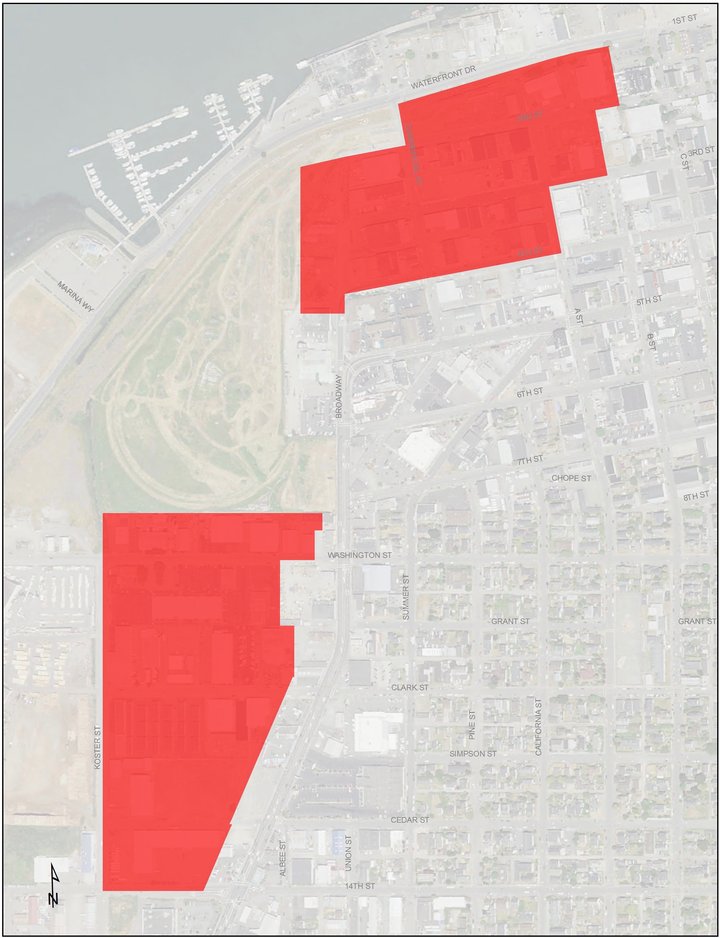
Eureka’s light industrial areas flank the Balloon Track property in the city’s northwest corner.
PREVIOUSLY:
- Part 1: RM-2500 (Residential Multi-Family)
- Part 2: RM-1000 (Residential Multi-Family)
- Part 3: RS-6000 (Residential Single-Family)
- Part 4: CS (Service Commercial)
- Part 5: CC (Central Commercial)
- Part 6: CP (Planned Shopping Center Commercial)
- Part 7: CN (Neighborhood Commercial)
- Part 8: CW (Waterfront Commercial)
- Part 9: OR (Office and Multi-Family Residential)
- Part 10: HM (Hospital-Medical)
From the City of Eureka’s Development Services Department:
Welcome to the 11th installment of our fourteen part series “Get to Know a Zone District.” In this series, a staff-member in the Planning Division answers questions about each Zoning District in the City. This month we will be exploring a really fantastic industrial zone: ML
1. What is ML? What does it stand for?
“ML” stands for “Manufacturing - Limited.” In everyday parlance most folks call it “Light Industrial”.
2. What’s it for?
It’s an industrial zone for uses that aren’t hardcore enough to require the MG (Manufacturing – General) AKA “Heavy Industrial” zone district. The basic premise is that the industrial uses “are not detectible beyond the boundaries of the site.” In the heavy industrial zone the uses are allowed to be detectible beyond the boundaries of the site.
3. I’m imagining stinky uses.
You imagine well. Stinkyness is a great qualifier. Noise or vibration-causing uses are others. Another hallmark of industrial uses is the heavy truck traffic that they generate.
4. I get that. I would not be stoked to live by stinky, vibraty, trucky uses.
A lack of stoke might be the least of your worries. The need for communities to segregate industrial uses was the main impetus for zoning in the early 20th century. At that time, rapidly industrializing American cities experienced deadly accidents on a regular basis. Even just a few years ago, the small town of West, Texas, was rocked when a fertilizer plant exploded. A nearby school and apartment buildings were destroyed. The damage and loss of life would likely have been dramatically lower if the industrial use would have been isolated.
5. Yeah, but seriously. How many industrial uses even have the potential to explode?
Some, to be sure…but you’re right that they are not a majority. Other industrial uses can tend to have a slower but equally destructive effect on public health. Exhaust from idling diesel trucks, industrial chemicals, and never-ending vibration can all be hazardous. When poor people end up living near industrial uses and get sick as a result it’s called an environmental justice issue. “The wrong side of the tracks” is usually downwind of a factory.
6. Why do we even want industry? Seems like pure hassle to me.
Industrial uses are often not glamorous and can be downright ugly…but they are job manna from economic development heaven. Industrial uses often fall into the category of basic industries, which create new incomes and generate spending in the local economy. Non-basic industries, in contrast, are just dollars redistributed. For example, the profit that a shellfish farmer receives when she sells her harvest to consumers in the bay area brings all of that “new money” up to Humboldt which she then spends locally at the grocery store or five and dime. When your favorite bartender spends some of his paycheck on a new beanie at a local clothing store, this “old money” is just circulating around the local economy. Tourism and government spending also bring “new money” into the local economy, and are much beloved for that reason.
7. I’m with you – but doesn’t America have a service-based economy? How does that fit in?
Good observation, and whoo-heee what a topic! There are many factors that affect the global economy, but generally speaking, a lot of heavy industrial uses which used to be done in the developed world are now being done in the developing world. As it pertains to land use, cities across the country are wrestling with what to do with “excess” industrial land. Will industry return? If so, where and what industries? How many people will be employed? Will robots take over? Will our existing transportation infrastructure be able to meet the demand? What if life really is all about waterfront condos and tasteful sweaters? There are many bright folks in the world publishing very insightful works on these topics. I encourage anyone to get out there and educate themselves on the economics of land use (which is to say, economics).
8. I’d really like to look at the City’s zoning map.
No prob. http://gis.ci.eureka.ca.gov/disclaimer_commdev.html
9. Where can I get more information about this and other zoning stuff?
The Development Services Department (and Planning Division) is open Monday-Friday 8am to 5pm (closed from noon-1:00) at City Hall. Stop by or call 441-4160 to speak with a planner.
# # #
Bonus Writing Prompt: In the comment section below, please describe a land use regulation that has touched you personally.
CLICK TO MANAGE